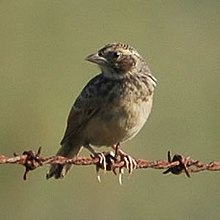Horsfield's bush lark
| Horsfield's bush lark | |
|---|---|
 |
|
| Scientific classification | |
| Kingdom: | Animalia |
| Phylum: | Chordata |
| Class: | Aves |
| Order: | Passeriformes |
| Family: | Alaudidae |
| Genus: | Mirafra |
| Species: | M. javanica |
| Binomial name | |
|
Mirafra javanica Horsfield, 1821 |
|
| Subspecies | |
|
see text |
|
see text
The Horsfield's bush lark or Australasian bushlark (Mirafra javanica) is a species of lark which inhabits grassland throughout most of Australia and much of Southeast Asia. The alternate shortened name "bush-lark" can also refer to many of the other species in the genus Mirafra. The alternate name of "cinnamon bush lark" is an alternate name for the flappet lark, and the alternate name of "singing bush lark" more commonly refers to the species of the same name, Mirafra cantillans. Other alternate names for Horsfield's bush lark include Australasian lark, Australian lark, Eastern bush lark, Eastern lark, Eastern singing bush lark, Horsfield's lark and Javan Lark.
The Horsfield's Bushlark is one of 90 species of larks of the rather large and fairly diverse Alaudidae family. They are small to medium-small passerines, usually with rather drab, brownish plumage. Predominantly an Old World family the species are distributed widely across Europe, Africa, Asia and the Indian subcontinent but Horsfield's Bushlark is the only species occurring naturally in Wallacea, New Guinea and Australia and the Horned Lark Eremophila alpestris, the only representative occurring naturally in the Americas.
Morphologically, the family Alaudidae constitutes a well defined group, whose members share unique features of the syrinx and tarsus. The syrinx lacks a pessulus, which is unique among oscines but occurs in many suboscine genera. They have a single fossa at the head of the humerus, rather than the double fossae of other passeroid songbirds, but typical of corvoid songbirds. Linear classifications have generally placed them at the beginning of the oscine passerines whereas, based on DNA–DNA hybridization they were placed in the super-family, Passeroidea. However, recent studies based on sequence data, have unanimously shown them to be part of the super-family Sylvioidea. Together with the morphologically and ecologically radically different monotypic genus, Panurus (Panuridae), they form a sister clade to the rest of the Sylvioidea.
...
Wikipedia

